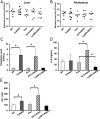Lipopolysaccharide clearance, bacterial clearance, and systemic inflammatory responses are regulated by cell type-specific functions of TLR4 during sepsis
- PMID: 23562812
- PMCID: PMC3644895
- DOI: 10.4049/jimmunol.1300496
Lipopolysaccharide clearance, bacterial clearance, and systemic inflammatory responses are regulated by cell type-specific functions of TLR4 during sepsis
Abstract
The morbidity associated with bacterial sepsis is the result of host immune responses to pathogens, which are dependent on pathogen recognition by pattern recognition receptors, such as TLR4. TLR4 is expressed on a range of cell types, yet the mechanisms by which cell-specific functions of TLR4 lead to an integrated sepsis response are poorly understood. To address this, we generated mice in which TLR4 was specifically deleted from myeloid cells (LysMTLR4KO) or hepatocytes (HCTLR4KO) and then determined survival, bacterial counts, host inflammatory responses, and organ injury in a model of cecal ligation and puncture (CLP), with or without antibiotics. LysM-TLR4 was required for phagocytosis and efficient bacterial clearance in the absence of antibiotics. Survival, the magnitude of the systemic and local inflammatory responses, and liver damage were associated with bacterial levels. HCTLR4 was required for efficient LPS clearance from the circulation, and deletion of HCTLR4 was associated with enhanced macrophage phagocytosis, lower bacterial levels, and improved survival in CLP without antibiotics. Antibiotic administration during CLP revealed an important role for hepatocyte LPS clearance in limiting sepsis-induced inflammation and organ injury. Our work defines cell type-selective roles for TLR4 in coordinating complex immune responses to bacterial sepsis and suggests that future strategies for modulating microbial molecule recognition should account for varying roles of pattern recognition receptors in multiple cell populations.
Figures






Similar articles
-
Suppression of PTRF alleviates the polymicrobial sepsis induced by cecal ligation and puncture in mice.J Infect Dis. 2013 Dec 1;208(11):1803-12. doi: 10.1093/infdis/jit364. Epub 2013 Aug 1. J Infect Dis. 2013. PMID: 23908488 Free PMC article.
-
Toll-like receptor 4 deficiency increases resistance in sepsis-induced immune dysfunction.Int Immunopharmacol. 2018 Jan;54:169-176. doi: 10.1016/j.intimp.2017.11.006. Epub 2017 Nov 14. Int Immunopharmacol. 2018. PMID: 29149705
-
Enhancing Nrf2 pathway by disruption of Keap1 in myeloid leukocytes protects against sepsis.Am J Respir Crit Care Med. 2011 Oct 15;184(8):928-38. doi: 10.1164/rccm.201102-0271OC. Epub 2011 Jul 28. Am J Respir Crit Care Med. 2011. PMID: 21799073 Free PMC article.
-
Early innate immune responses to bacterial LPS.Curr Opin Immunol. 2017 Feb;44:14-19. doi: 10.1016/j.coi.2016.10.005. Epub 2016 Nov 12. Curr Opin Immunol. 2017. PMID: 27842237 Free PMC article. Review.
-
The Battle of LPS Clearance in Host Defense vs. Inflammatory Signaling.Cells. 2024 Sep 21;13(18):1590. doi: 10.3390/cells13181590. Cells. 2024. PMID: 39329771 Free PMC article. Review.
Cited by
-
Role of endotoxemia in causing renal dysfunction in cirrhosis.J Investig Med. 2020 Jan;68(1):26-29. doi: 10.1136/jim-2019-001056. Epub 2019 Jul 19. J Investig Med. 2020. PMID: 31324695 Free PMC article. Review.
-
Lipid A Remodeling Is a Pathoadaptive Mechanism That Impacts Lipopolysaccharide Recognition and Intracellular Survival of Burkholderia pseudomallei.Infect Immun. 2018 Sep 21;86(10):e00360-18. doi: 10.1128/IAI.00360-18. Print 2018 Oct. Infect Immun. 2018. PMID: 30037795 Free PMC article.
-
Derivation, Validation, and Potential Treatment Implications of Novel Clinical Phenotypes for Sepsis.JAMA. 2019 May 28;321(20):2003-2017. doi: 10.1001/jama.2019.5791. JAMA. 2019. PMID: 31104070 Free PMC article.
-
Role of G-CSF in monophosphoryl lipid A-mediated augmentation of neutrophil functions after burn injury.J Leukoc Biol. 2016 Apr;99(4):629-40. doi: 10.1189/jlb.4A0815-362R. Epub 2015 Nov 4. J Leukoc Biol. 2016. PMID: 26538529 Free PMC article.
-
Emerging mechanisms of immunocoagulation in sepsis and septic shock.Trends Immunol. 2021 Jun;42(6):508-522. doi: 10.1016/j.it.2021.04.001. Epub 2021 Apr 24. Trends Immunol. 2021. PMID: 33906793 Free PMC article. Review.
References
-
- Tidswell M., LaRosa S. P. 2011. Toll-like receptor-4 antagonist eritoran tetrasodium for severe sepsis. Expert Rev. Anti Infect. Ther. 9: 507–520 - PubMed
-
- Wiersinga W. J. 2011. Current insights in sepsis: from pathogenesis to new treatment targets. Curr. Opin. Crit. Care 17: 480–486 - PubMed
-
- Carpenter S., O’Neill L. A. 2007. How important are Toll-like receptors for antimicrobial responses? Cell. Microbiol. 9: 1891–1901 - PubMed
-
- Vodovotz Y., Liu S., McCloskey C., Shapiro R., Green A., Billiar T. R. 2001. The hepatocyte as a microbial product-responsive cell. J. Endotoxin Res. 7: 365–373 - PubMed
-
- Bauer S., Müller T., Hamm S. 2009. Pattern recognition by Toll-like receptors. Adv. Exp. Med. Biol. 653: 15–34 - PubMed
Publication types
MeSH terms
Substances
Grants and funding
LinkOut - more resources
Full Text Sources
Other Literature Sources
Molecular Biology Databases
Miscellaneous

